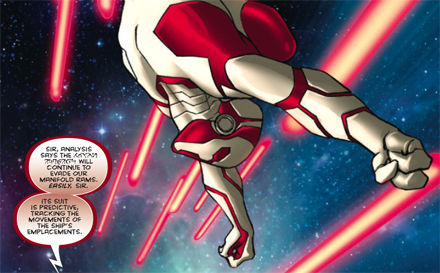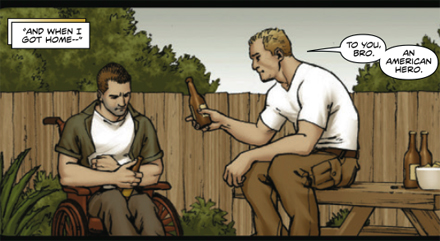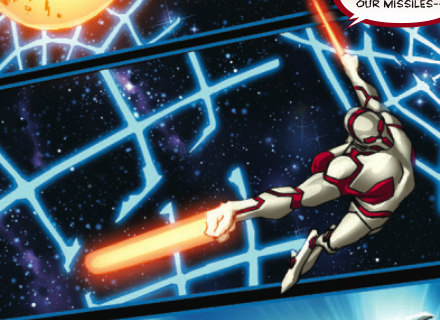This is what happens when Techland goes to the comic book store: we end up discussing what we picked up. This week, Douglas Wolk, Graeme McMillan, Evan Narcisse and Mike Williams discuss Soldier Zero #1 and the Vertigo Resurrected anthology.
DOUGLAS: Soldier Zero: well, that’s not the greatest hand Paul Cornell and Javier Pina were dealt. This would have been a perfectly acceptable Marvel comic in 1974: a decently executed first-issue-of-a-superhero-comic/origin story that’s basically a rewrite of Green Lantern’s origin, with a touch of Blue Beetle (actually, I think the “alien” typeface might be the same one that turned up in the Jaime Reyes Blue Beetle–or maybe it’s Kryptonian). But there have been so many of those dropped on the pile over the past 35 years that I need a really big reason to care about it, and Stan Lee’s signature is not it.
(More on Techland: The Comic Book Club: “Strange Tales II” and “Knight and Squire”)
Beyond being a little weirded out that Lee gets his name on the cover twice, despite not actually writing the story inside, I’m generally bummed that two out of every three people in comics seem to be working on a “Stan Lee” project with which Lee’s got minimal involvement. Lee did some very, very important things for comics between 1960 and 1972, and I suspect he’s still got his gift of pushing certain collaborators to extend themselves (have y’all been reading that backup strip he’s been writing in Amazing Spider-Man? Marcos Martin is doing incredible work over there). But he’s basically running on name recognition rather than what he’s been doing for the past few decades; every time I see his signature I think of Gusteau from Ratatouille.

This issue reads like Cornell is much more invested in Stewart Trautmann than in the dude in red and white armor. Which is fine–except that it gives me no reason to be interested in the armored dude. It’s an interstellar war. Another interstellar war. I am so tired of interstellar wars I can’t even tell you.
EVAN: Yeah, this one reminded me of the Jaime Reyes Blue Beetle character, too. And that’s a problem. If there’s one thing that a comic with the words “Stan Lee” all over it shouldn’t be, it’s derivative. I started thinking that this would be a great comic for a tween/teenage kid, but the caveat is that said kid couldn’t have heard of Green Lantern or Blue Beetle or Nova or Ben 10 or… You get the point. Aside from the character’s wacky-looking armor and the paralyzed civilian thing, this reads as by-the-numbers. Which isn’t necessarily bad, it’s just doesn’t have enough mojo to break the surface and stand out as something different.
I’m sick of writers doing the whole broken-sentence, naturalistic dialogue thing. It’s risen in popularity since Bendis became a superstar but, in the wrong hands, it’s terrible. I hate to say it, but Cornell’s hands are the wrong ones here. The stop and start doesn’t flow well. It’s like a lurching cab ride. You don’t need characters to sound like they do in real life. It’s just weird to read this from Cornell, who hasn’t done it in Action or in Knight and Squire.
(More on Techland: The Comic Book Club: Thor #615)
But the real reason I wanted to read this one was, of course, because of Stan Lee. Just before NYCC, I randomly ran into Stan and a few of his handlers in the street. Shook his hand and told him I was a fan. His grip was strong, he seemed alert and attentive. But the question I couldn’t shake was: Why is Stan still doing all of this?

Is he broke? Can he not stay away? Is his filter broken, so that he can’t discern the moments to make a lasting mark in his latter-day work from the people who just want him to rubber-stamp stuff? I think back to that Just Imagine stuff with DC, which, while it wasn’t great, felt like Stan The Man. Or one of Stan’s personas. Soldier Zero doesn’t have that crazy Stan vibrancy.
I’ve never been able to shake the great anecdote from an old Matt Fraction column at CBR. It’s in the first graf, and ever since I read it, I’ve been left to wonder if the superhero business can’t let go of Stan or vice versa. It makes me wince a bit to think that Stan can’t or won’t be an eminence grise to the comics industry, like Joe Kubert and Jerry Robinson have kind of become.
DOUGLAS: I’m with you there. Also, Javier Pina’s artwork this issue? Totally competent, totally generic. There is no excuse for that at this stage of the game. Looking at the other comics I picked up this week, Frazer Irving’s artwork in Batman & Robin #15 is deep and wild and distinctive, Chris Samnee is drawing the hell out of Marvel’s third-tier Thor series, Roger Langridge is drawing what has to be an incredibly tightly controlled licensed title, The Muppet Show, and giving it personal character and flair… And on the first issue of a new superhero series–the first issue of a new imprint–we get something this by-the-numbers?

GRAEME: Yeah, it all felt very generic. I got the Green Lantern bite, but it felt like Kyle Rayner Green Lantern, not even Hal Jordan – Very familiar, very done before. Cornell’s dialogue feels… off, I guess? It’s not the attempt at naturalistic dialogue, but it seems very “someone who doesn’t live in America’s attempt at American,” for want of a better way to put it, and made all of the characters immediately seem bland and unrealistic as a result (especially the conversation between the two women early in the issue, which was just surreally awkward). It’s a shame, considering it’s the start of a line that I have some interest in (I’m looking forward to Mark Waid’s time travel series in particular), but this was just dull.
(More on Techland: The Comic Book Club: “Love & Rockets” and “X-23”)
MIKE: I thought maybe at times I was enjoying this book, but now that I’m done, I think no, no I didn’t. I realize now it’s because it was half Avatar and half Green Lantern. Unfortunately, every time I see a character that springs from a wheelchair to suddenly have super powers I think of that joke of a TV series M.A.N.T.I.S., and that is not a good thing. I feel as though I can already see the first few story arcs in the series. He’s going to battle a pile of aliens sure but he’s also going to come to grips with his powers. He’s going to experiment with his new suit and make some strange discovery as to its origin or power source. He’s going to have a dramatic breakup with his new girlfriend because she can’t understand what it’s like being a disabled man who is secretly a cape. Then he’ll probably have to rescue her from some mustache twiddler. Blah, blah, blah, when do the 32 individual Stan Lee hockey books come out?
EVAN: Hey. HEY! Don’t talk trash about my M.A.N.T.I.S. Yes, the series sucked, but damn if that pilot wasn’t 10 kinds of awesome.
MIKE: So YOU were the one watching it? Well, I guess I watched my share of episodes as well.
Oh, and Douglas, forget about the fact that Stan’s name is on the cover twice: how about the interior credits page where he is listed, on his own line, as the Grand Poobah? Why not Comics Shaman or the Earl of Character Creation?
DOUGLAS: Well, it’s gotta be something. As I understand, he’s participating in this line in some capacity–maybe vetting things or making suggestions–but it’s not any of the standard roles.
(More on Techland: The Comic Book Club: “You’ll Never Know” and “Action Comics”)
Anyway: on to Vertigo Resurrected #1. The point of this one seems to be to publish “Shoot,” the story about school murders in America by Warren Ellis and Phil Jimenez, originally scheduled for Hellblazer #141 but unpublished until now (it was completed before Columbine, scheduled to appear shortly after it, and shelved when Ellis refused to make changes in it); it’s one of DC’s new $8, 100-page reprint books, filled out with one-off stories from various 1997-2000 anthology titles.
The reputation of “Shoot” has probably been enormously enhanced by its having been “banned”; it’s really not a particularly good story at all. Ellis sets up a mystery–how is it that this mysterious John Constantine fellow keeps turning up in pictures of schoolyard killings? And then he doesn’t resolve it–he just has Constantine come on and give a self-righteous lecture. (And I have to say: it’s not that school murders are off-limits, or aren’t a fertile subject for interesting art. I actually just read an absolutely fascinating novel, Adam Levin’s The Instructions, which is more or less about that–but its analysis is a good deal more inventive and thoughtful than “you know why kids kill kids? Because American kids are so miserable that they totally want to die.”) The interesting thing is that Jimenez is absolutely at the top of his form here–he’s got a story that’s mostly talking heads and still photos, and he stages it so well and so dramatically that it looks exciting all the way through.
Some clever picks for the reprinted stories here, though. Bill Willingham’s “It Takes a Village” anticipates what he started doing a few years later with Fables; Grant Morrison and Frank Quitely’s “New Toys” isn’t their best work, but it’s one of the earliest Morrison/Quitely collaborations, and somewhere on the continuum between Toy Story and Joe the Barbarian; Brian Bolland’s “The Kapas” is eight pages of Brian Bolland (I wonder if that’s the longest single story he’s done since The Killing Joke? He’s got another eight-pager in next month’s issue of DC Universe Legacies, too!).
Now, how about another “Vertigo Resurrected” with Rick Veitch’s original Swamp Thing #88?
(More on Techland: “Deadpool” and “Daredevil: Black and White”)
MIKE: Well, I can see why DC took a pass on “Shoot.” As I was reading it I kept thinking how much it reminded me of some of the earlier episodes of Fringe (which themselves harken back to The X-Files). The entire pacing of the story was presented as a mystery. What’s causing these school shootings? Who is this man at all the scenes? The final pages, of course, tip the entire story on its ear, and it made me sit back in my chair and think very hard about what this book might be saying about me. After all I was a violence-desensitized suburban do-nothing in high school. Certainly I wouldn’t have just stood there and watched someone shoot up a room full of my peers? Wait, do I hate myself?
The pacing of the book was excellent, I thought. Fast. That could be because I’m pretty sure that I’ve listened to part of the Jonestown Massacre tapes and I can imagine how someone listening to them over and over might be affected. As far as John’s entrance, I couldn’t help but notice the liberal sprinkling of UK slang in his word bubbles. It seemed forced and out of place. In fact, his angry and confrontational tone throughout doesn’t make sense until those final pages.
GRAEME: Yeah, “Shoot” was… weird. It doesn’t even really make sense. Is there any real explanation given for why Constantine is at all those shootings, beyond “I’m checking out shootings for a friend?” And the rant at the end reminded me that Ellis’ Hellblazer was, at its best, journalism disguised as comics. There’s no real narrative here, it’s a rant with some art from Phil Jiminez (whose work here is so… glossy, I want to say, so not right for the subject matter or the character, that it reminds me how out of place I felt like his stuff was on The Invisibles, way back when).
(More on Techland: The Comic Book Club: “The Last Phantom” and “Set to Sea”)
As for the other material in there… Eh, it’s nice enough, I guess? The Morrison/Quitely story was a nice surprise, but felt very familiar, as if it should be part of Flex Mentallo or something. It’s also the best of the shorts, although I really liked the Steve Niles/Tim Sale short, if only because Sale’s work is gorgeous. Overall, though, it’s a fairly weak package for $7.99. Hopefully, someone can come up with a better use of the format for Vertigo in the future. Maybe we could get a quiet Flex Mentallo collection through this format…?
EVAN: My first reaction upon reading “Shoot” was to wonder what all the fuss was about. Even though it’s been floating around the internet for years, I’d never read it. And once I did, it surprised me by not being as explicitly violent as I was led to believe. It seems like the difference must’ve been more of a philosophical one as to what the story meant. But, honestly, John Constantine is a git. The things that come out of his mouth are meant to inflame, and in that way, “Shoot”‘s totally in keeping with the characterization set up by Alan Moore all those years ago.
As for the rest of the collection, most of it felt like stuff pulled up to fill out the book. I like the Morrison and Quitely tale, especially that last creepy page. But all of the back-up work felt too ridden with weird tics–everybody working the EC influence out of their systems–to have the bigger impact that “Shoot” does.
Man, I would love to see Flex Mentallo in this format.

